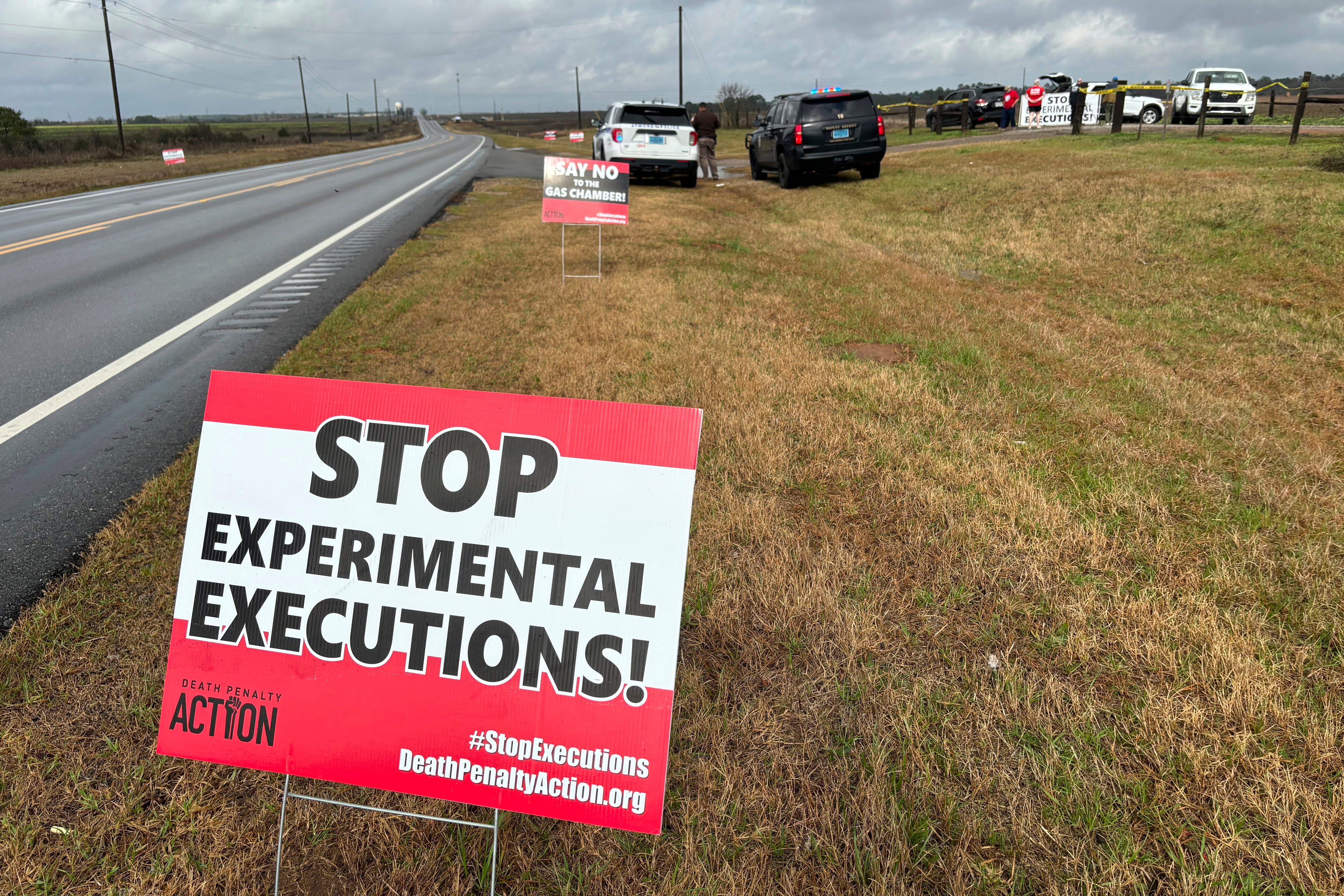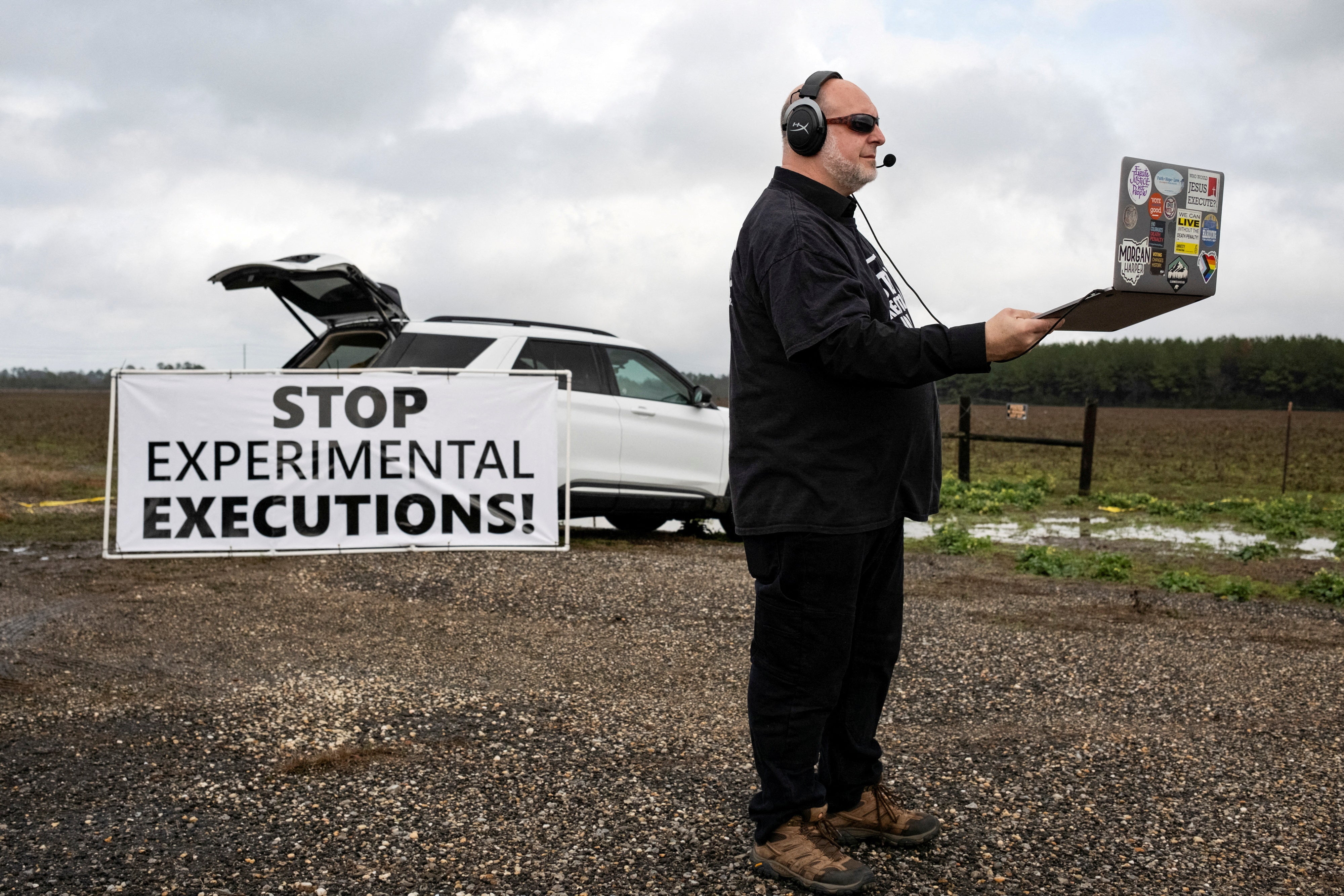The United Nations has expressed concern that the use of nitrogen in an execution in Alabama may constitute torture.
Kenneth Eugene Smith, a prisoner on death row in Alabama, has been put to death using nitrogen gas. This marks the first time in US history that this controversial method has been used for execution.
Smith, who was 58 years old, was declared deceased at 8:25pm CT on Thursday at the William C Holman Correctional Facility in Atmore, Alabama. This occurred almost thirty years after Smith’s conviction for the murder-for-hire scheme involving Elizabeth Sennett in 1988.
His spiritual counselor, Reverend Jeff Hood, who observed the execution, informed journalists that he witnessed a man “fighting for their life” for a shocking 22 minutes.
The state of Alabama maintains that the execution proceeded as planned, despite their prediction that the untested procedure would result in loss of consciousness within seconds and death within minutes.
However, according to witnesses, Smith seemed to be awake and aware for a few minutes while on the gurney, shaking and squirming.
“We didn’t see somebody go unconscious in 30 seconds,” said Rev Hood. “What we saw was minutes of someone struggling for their life.”
Smith passed away following the rejection of his last-minute request to delay his execution by the US Supreme Court. Justice Sonia Sotomayor expressed her disagreement with the decision, stating that the state had chosen Smith as an experimental subject by utilizing an unproven procedure.
Alabama Attorney General Steve Marshall reacts to Smith’s death
The Attorney General stated in a written declaration that Kenneth Smith was executed tonight for the brutal killing he carried out 35 years ago. His victim, Elizabeth Sennett, was an innocent woman described as a devoted wife, caring mother and grandmother, and a respected member of her community.
I urge the citizens of Alabama to come together and offer prayers for the family and friends of Elizabeth, in hopes that they may find the peace and closure they have been seeking.
The passing of Smith was a significant moment as it was the first instance globally of utilizing nitrogen hypoxia, a method of gradually cutting off oxygen to a prisoner through a specialized mask. The Attorney General referred to it as a “momentous occasion.”
According to him, activists are not concerned about Alabama’s new method being both humane and effective, as they are aware that it is also easily implemented.
“Despite the efforts of activists to undermine and criticize our state’s justice system in denying justice to victims of brutal murders, our proven method serves as a model for other states and a warning to those who would consider taking innocent lives.”
VIDEO: Minister exposes the gruesome details of Kenneth Smith’s death sentence.
A witness gives an account of the execution of Kenneth Smith using nitrogen gas, a first in history.
IN PICTURES: Anti-death penalty protesters outside the Alabama prison
Activists against the death penalty have placed signs along the road leading to the Holman Correctional Facility.

Activists who oppose the use of the death penalty have placed signs along the road leading to the Holman Correctional Facility.
Protesters against the death penalty gather outside Atmore prison in anticipation of the execution.

Signs are placed by activists against the use of the death penalty along the road leading to Holman Correctional Facility.
Abraham Bonowitz, co-founder and executive director of Death Penalty Action, standing outside the prison:

Abraham Bonowitz, one of the co-founders and executive director of Death Penalty Action, standing outside the prison.
The United Nations’ top official for human rights denounces the killing of Kenneth Smith.
What led to Kenneth Eugene Smith’s placement on death row?
Smith was found guilty of killing Elizabeth Dorlene Sennett in a premeditated murder scheme in Colbert County, Alabama in 1988.
Sennett was the spouse of Charles Sennett, a pastor of the Church of Christ. It is alleged that Sennett paid $1,000 to Smith and another individual to murder his wife.
According to court documents, the pastor was reportedly heavily indebted and sought to claim insurance money upon her death.
Sennett met a violent end within her residence.

The victim was attacked with a tool from the fireplace and suffered 10 stab wounds to her chest and neck. The scene of her death was made to appear like a break-in and theft.
In 1989, Smith received a death penalty for committing capital murder, but the ruling was reversed on appeal in 1992.
The jury voted 11 to one to sentence him to life in prison without the possibility of parole.
However, Smith was ultimately not exempt from a sentence of death, as a judge overturned the jury’s decision and sentenced him to death for the second time in 1996.
The execution was surprisingly violent and caused shock.
Lee Hedgepeth, who was present during Kenneth Eugene Smith’s execution, has expressed that there was a sense of surprise in the room due to the extreme violence of the execution.
He informed the BBC’s Newsday programme that he had attended four past executions and had never witnessed a condemned prisoner struggle as much as Kenneth Smith did when exposed to nitrogen gas.
Kenny started struggling to breathe and the execution lasted 25 minutes in total.
What states permit the use of nitrogen gas for executions?
As of now, three states have authorized the utilization of nitrogen gas for carrying out death sentences on inmates.
The three states are Alabama, Oklahoma, and Mississippi.
Both Oklahoma and Mississippi have never utilized the execution method.
In 2018, Alabama became the first state to implement this method, and it was used for the first time on Thursday, January 25th when Kenneth Eugene Smith was executed.
In the first case of its kind on death row, Kenneth Smith was executed in Alabama using nitrogen gas. This marks the first time that this method has been used for execution.
In a historic event on death row, Kenneth Smith was put to death in Alabama through the use of nitrogen gas. This is the initial instance of this method being employed for an execution.
Convicted murderer Kenneth Smith thrashed violently and repeatedly gasped for air during a 22-minute execution as he became the first inmate to be put to death with nitrogen gas.
Last night at William C. Holman prison in Atmore, Alabama, a 58-year-old inmate was restrained to a gurney and equipped with a mask and breathing tube. The gas administered through the tube gradually deprived him of oxygen.
Shortly before his execution, he uttered the words “I depart with love, peace, and light” before facing his family and gesturing “I love you.”
Reporters in attendance detailed Smith’s apparent difficulty during his execution. Lee Hedgepeth stated, “I have attended four previous executions and I have never witnessed a death row inmate thrashing like Kenneth Smith did in response to the nitrogen gas.”
Please read the complete article:
The pastor of Kenneth Smith stated that the corrections officials were noticeably taken aback by the severity of the situation.
The spiritual counselor of Kenneth Eugene Smith asserts that even the Alabama authorities present were visibly stunned by the use of nitrogen asphyxiation to execute the inmate.
Before Smith was put to death, the state announced that they would use a method that had never been used before. They predicted that he would lose consciousness within seconds and pass away in a matter of minutes.
Numerous individuals who were present and members of the press have disclosed that this was not true.
Reverend Jeff Hood stated during a press conference following the execution that there were corrections officials present in the room who were visibly taken aback by the severity of the situation.
“I am aware that Commissioner Hamm of [Alabama Department of Corrections] and ADOC will likely claim that this was their expected outcome, but their court documents prove otherwise.”
He stated: “I believe anyone who saw this can attest that we did not observe someone lose consciousness in just two or three seconds… We did not witness someone lose consciousness in 30 seconds.”
The pastor stressed the importance of preventing this from happening in the future.
The human rights group condemns the false claim that the execution was humane.
The execution of Kenneth Eugene Smith has been condemned as inhumane by human rights group Reprieve, who call it a “falsehood”.
Maya Foa, Director of Reprieve US, stated to The Independent after the execution:
“They asserted that lethal injection was a humane method – which was untrue. They will likely argue that this execution was also humane, which is another falsehood.”
The main goal of these techniques is to conceal suffering. How many additional inmates must suffer excruciating deaths before we acknowledge that executions are simply the government violently ending a person’s life?
Source: independent.co.uk



